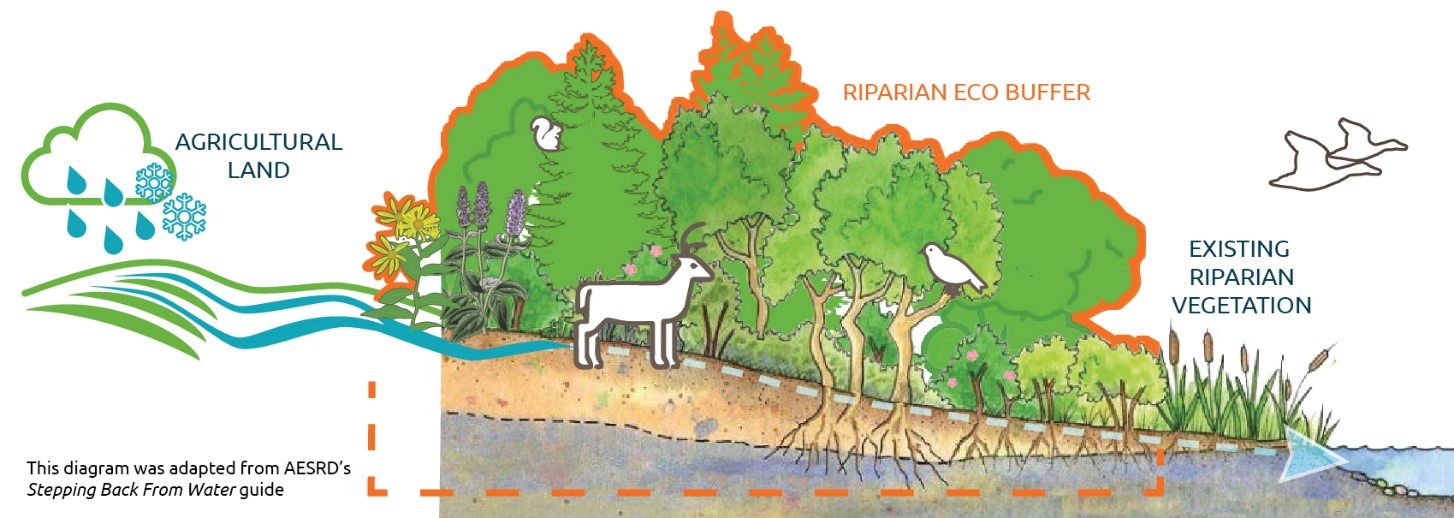Buffering our impact: How Eco-Buffers can help reduce our impact on the river and provide ecosystem services.
Written by Heather J. Marshall
What is a Riparian Eco-Buffer and why are they important?
Riparian Eco-Buffers are plantings of perennial trees, shrubs, and flowers near water bodies. They re-establish native riparian areas with vegetation that benefits waterways and the surrounding ecosystem.
Like traditional single-species shelterbelts, Riparian Eco-Buffers:
- Reduce wind speed and prevent wind erosion
- Provide habitat for livestock or wildlife
- Trap and store snow and water
Unique aspects of Riparian Eco-Buffers:
- Arranged to mimic natural forests with higher density planting and more diverse species
- Use native species, which have deeper roots and are better adapted to prairie conditions
- Are less prone to weeds and require less maintenance
- Attempt to connect buffer to existing natural areas or riparian zones
How Riparian Eco-Buffers benefit water bodies and the surrounding ecosystem:
- Slow water during flooding and store water for dry seasons
- Recharge aquifers and groundwater levels
- Filter out pollutants and nutrients from runoff to maintain water quality
- Stabilize banks to conserve soil and prevent erosion
- Encourage biodiversity and provide habitat for pollinators, birds, and wildlife
- Foster mutually beneficial relationships between native species
This diagram shows how water flows through an Eco-Buffer and the many benefits the riparian vegetation provides to water bodies and the surrounding ecosystem.
Examples of Eco-Buffers: Demonstration sites in the Vermilion River watershed
River Revival Event, Vegreville 2019
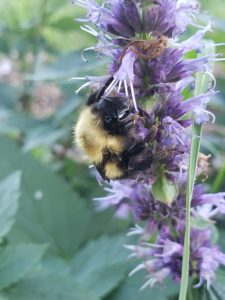
WHEN: June 2019
WHO: NSWA and VRWA, Agroforestry Woodlot Extension Society (AWES), the Town of Vegreville, and the Vegreville Regional Museum
WHAT: Hosted a public “River Revival” event to plant 200 trees and shrubs and 36 native wildflowers
WHERE: On the Vegreville Regional Museum grounds next to the Vermilion River
WHY:
- Educate: NSWA and AWES presented information on riparian area health and the role of an Eco-Buffer in establishing a healthy ecosystem.
- Participate: 25 event participants took part in planting native seedlings and wildflowers on a pre-prepped area of the museum, adjacent to the Vermilion River. Kid’s crafts and activities were also offered.
- Celebrate: After planting, participants enjoyed a BBQ to cap off the event.
LATER: Three pounds of native grasses were seeded between rows as groundcover. This prevents weeds and reduces long-term maintenance.
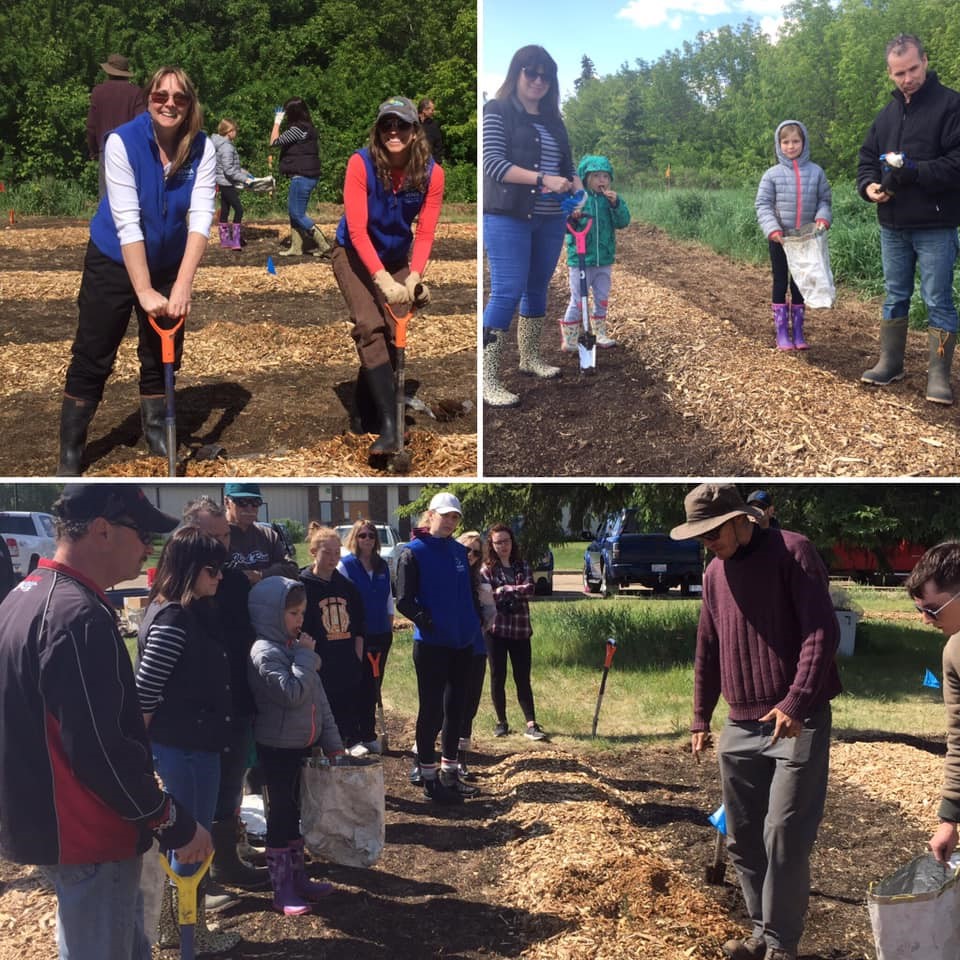

River Revival Event, Two Hills 2020
The original plan for the 2020 Two Hills River Revival Event was to have AWES educate local school kids about Eco-Buffers and then have the kids help with the planting. This plan was adapted with the advent of COVID.
The Revised Plan:
- May 15: AWES staff partnered with the Town and County of Two Hills staff to help lay the plastic mulch blanket at Geleta Park in Two Hills
- May 25: Two AWES employees planted 300 trees and shrubs in the Eco-Buffer rows.
- Excess trees were planted in other parts of the Town and County of Two Hills, including the local Trout Pond
- A total of 415 trees and shrubs were planted in the Riparian Eco-Buffer
- Native grasses were seeded between rows as groundcover
- VRWA is still hoping to host an educational event and plant the wildflowers in the Fall of 2020 or in the Spring of 2021.
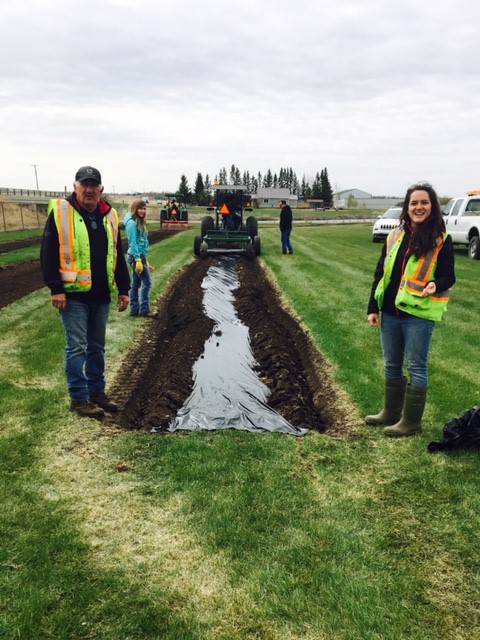
Did you know: plastic mulch or “consolidated mulches” can offer more effective, long-term weed protection when planting in an area with high competition among plants.
For more information, check out our infographic here, or click here to read The Practical Guide to Establishing an Eco-Buffer.
Special thanks to all our project partners and volunteers for helping to establish these demonstration sites in the Vermilion River watershed.
These projects were funded by the Watershed Resiliency and Restoration Program of the Government of Alberta.
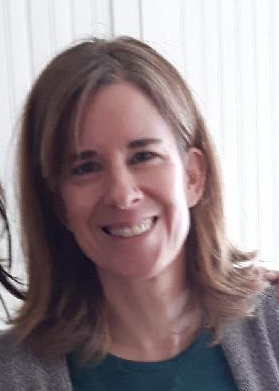
Heather J. Marshall is a freelance writer and graphic designer. Her main interests are local food and history, human connection to the environment, and biographical stories. To contact Heather, please go to: hmmcreate.myportfolio.com

